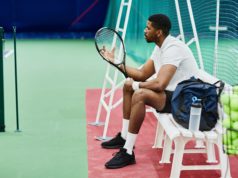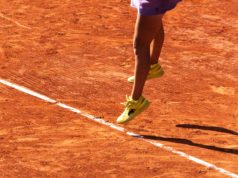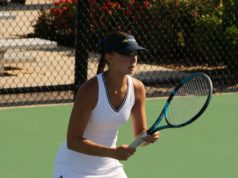By Zwelo Khupe, Owner, Precision Tennis; Tennis Professional at Kennworth Tennis Center
There are many ways to improve your game from one level to another. Generally, it is easier to improve from a pure beginner level to the next one (i.e., intermediate level), but it is much more difficult at advanced levels (say, high-performance or collegiate level).
For beginners, the following can be significant: Get a certified coach, not a friend who claims to be an expert because he or she is better than you at tennis. Such “experts” can have you develop bad habits that may be hard to eliminate once you find a real tennis coach.
There is a cost for gaining expert advice or a skill. Invest in real tennis equipment. First, running shoes are not tennis shoes. Running shoes are built for forward movement, not lateral movement. When playing tennis, you may need to move laterally, and you need shoes that can support such movement. Second, buy a real racquet made of graphite, not a big-box store version made from aluminum. Proper equipment matters. Allow the experts or your preferred tennis store to help find the right shoes and racquet for you.
Now, let’s explore a few ways one can learn to move from a lower-level player to a high-performance player:
1. Fitness Level
You can improve your fitness level by running just two miles, three times a week. Do wind sprints. For juniors, I prefer to stay away from weights unless a trained professional is working with a junior player on a fitness regimen. Push-ups and wind sprints are examples of strengthening methods that do not require weights.
2. Footwork
Movement is key to improving your game, especially for high-performance level players. I work with a player that went from one level to maybe two levels up because we improved his movement significantly. Agility ladder, movement drills, and increased fitness levels are ways to improve one’s movement.
3. Diet
Eliminating some food groups from your diet (gluten, sugary foods) can go a long way in getting your body to perform at a higher level. Consult a nutritionist for juniors as they may still be growing. Hydrating days before competition is key, as is staying away from drinks that can cause dehydration such as sodas and tea and such.
4. Discipline
One of the most underrated ways to improve in life, sports, or any field really. Undisciplined players are less likely to achieve their potential. In tennis, disciplined players tend to pay attention to details. They are much easier to teach, as they are more attentive and are more open minded to new ideas. And they are less likely to make excuses; they take ownership to failures.
5. Hard Work
Outwork your competition. Be willing to do more than your peers. Successful athletes (Tiger Woods comes to mind) are people who practice more than their competition. It will always give you an edge.
6. Equipment
There is proper equipment and stuff people get by with. Invest in proper racquets, shoes, and strings. Tennis equipment can be expensive at times; I realize. When I was a junior, my racquet was my most prized possession. I knew it needed to last me for years.
USTA GEORGIA-GPTA TEACHING PROFESSIONAL SPOTLIGHT: Zwelo Khupe
 Hometown (City/State): Marietta, Georgia
Hometown (City/State): Marietta, Georgia
How did you get involved in teaching tennis? I was a college tennis player and am naturally a teacher.
Diehard fan of what sports team? Tottenham Hotspurs
Best part of your game? All-around game.
Dream doubles match would be me and… my brother, Mkhululi Khupe.
When I’m not teaching tennis, I’m… Playing soccer or golf.
My favorite tennis memory is: Collegiate conference match against Armstrong State University.
My favorite professional player is: Ivan Lendl
#1 reason why I enjoy teaching & coaching tennis: Seeing players develop from beginner levels to high-performance level. It’s the biggest thrill for me by far.
What important tennis message do you want to promote? We as teachers must make the tennis court a playground. Children like the playground, so make the court, along with balls, racquets, and other teaching tools into a playground of sorts.




